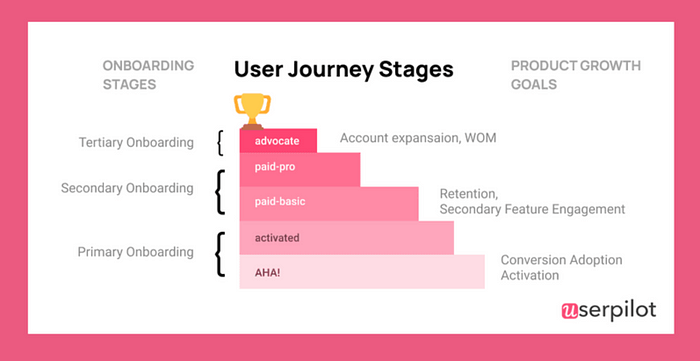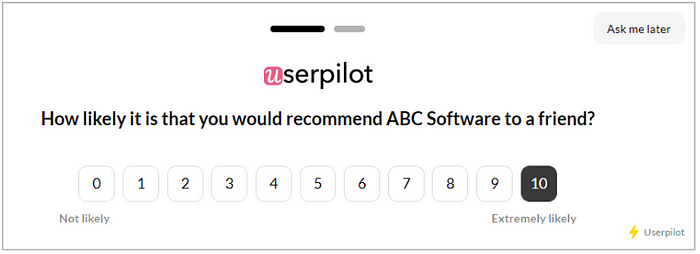5 Key User Retention Metrics for SaaS [+ How to Measure and Improve Them]
You probably all know the famous study that claims increasing user retention metrics by only 5% can increase profits by as much as 25–125%. And it makes sense — in a subscription business model, most of your revenue comes from recurring purchases — aka retaining your users — not from the new acquisitions.
So improving your user retention metrics can make or break the success of your product marketing efforts. Let’s take an all-angle look at the top-5 user retention metrics and the best strategies for improving them.
Table of Contents
What is user retention?
The importance of user retention metrics for SaaS
How to track user retention metrics
User Retention Metric #1 — Customer Churn Rate
User Retention Metric #2 — Customer Lifetime Value
User Retention Metric #3 — LTV to CAC Ratio
User Retention Metric #4 — User Retention Rate
User Retention Metric #5 — Net Promoter Score
Retention vs. Advocacy
TL;DR
- Working on user retention can maximize the amount of time customers spend using your product
- User retention is just as important as acquisition not to mention a lot cheaper
- Get new users to that “AHA moment” as soon as possible
- Five key metrics can give you a holistic view of user retention as a whole
- Get reviews from the customers with the highest NPS scores
- Don’t forget to cater to satisfied customers too as they can be even more valuable than upset users
What is user retention?
User retention is a metric that indicates how many customers out of 100 your keep vs lose in any given period of time. Your user retention strategy often requires extensive fine-tuning to get the best results and your approach will need to adapt as users make their way through the three onboarding stages.

The importance of user retention metrics for SaaS
Both experience and data show us time and time again that customer satisfaction is directly tied to your user retention metrics.
Studies show that user acquisition is anywhere from 5x to 25x more expensive than user retention. In essence, keeping your existing users is more cost-effective than trying to constantly find new ones.
Boosting your user retention rates by 5% can increase revenue by 25%-95% so has a huge impact on the bottom line. When it comes to the world of SaaS, the user retention process starts right after the user reaches their “AHA moment” and adopts your product (e.g. paying for the first month.)
The longer the user stays in your product, the higher chance they will have a positive Net Promoter Score. Simply because they’ve got more value out of your product.
And higher satisfaction means they are more likely to become advocates of your company who refer people to your product.
Checking your user retention metrics is the first step to gauge how many of the new customers you acquire you are going to keep. It’s essential to do before you invest heavily in user acquisition. Essentially, it’s akin to checking that your shoelaces are tied before going for a run.
How to track user retention metrics?
Measuring user retention may seem pretty straightforward. However, it can be quite nuanced considering the retention rate alone doesn’t give you the full story. Tracking the five key user retention metrics is the best way to get a holistic view of your SaaS user retention.
User Retention Metric #1 — Customer Churn Rate
Within the context of marketing, two types of churn can be used to measure the success of a specific product. Customer churn represents the percentage of customers lost in X amount of time and is measured by looking at subscription cancellations.
Revenue churn, on the other hand, focuses on the financial consequences that result from the lost customers. Both forms of churn are key performance indicators in any SaaS and they’re intertwined with one another.
To measure your customer churn rate you need to take the total number of lost (aka churned) users during the period, divide by the number of customers you had at the start of that period, then multiply the value by a hundred.

Both customer churn and revenue churn should come into play when you’re crafting/refining a product marketing strategy, but it’s ideal to start with the former. Understand why users stop using the product then fix that before looking at revenue churn.
How to improve Customer Churn rate
Spot potential churn users before you lose them so you can work towards keeping them on the platform
- Reach out to potential churn users and offer help
- Segments your users that display signs of churning
- Userpilot lets you create segments based on user behavior, engagement, user identification, and custom events

Learn from experience
- Trigger an in-app microsurvey whenever a user clicks the “cancel subscription” button:

Collecting qualitative data about the reasons your users churn will help you immensely in understanding what you need to improve in your product to improve your user retention metrics.
And maybe you can still change their mind by offering them to jump on the call to discuss the problem they indicated in the microsurvey before hitting that ‘cancel’ button?
User Retention Metric #2 — Customer Lifetime Value
Customer Lifetime Value (abbreviated as CLV or LTV) indicates the amount of money that a business earns from a single customer over the course of their business relationship with you.
This metric will help you understand how profitable each customer is and therefore how much you can justify spending on the user acquisition side of your marketing strategy.
There’s a simple and a complicated way to calculate your customer LTV. The quickest way would be to divide your Average Revenue per Account (ARPA) by your churn rate.
We delve deeper into the most effective ways to measure LTV and why it matters in our Customer Lifetime Value article — be sure to check it out to get a more in-depth look at the topic.

How to improve Customer Lifetime Value
- Customers will stick around as long as they continue to receive value from the product
- This means that the product gets the job done for them (remember the Jobs-To-Be-Done framework?)
- Rapid support via live chat and/or an in-app resource center is also crucial so users can get answers no matter where they are on the site

User Retention Metric #3 — LTV to CAC Ratio
Here’s a simple formula to measure the LTV to CAC ratio:

Your Customer Lifetime Value to Customer Acquisition Cost ratio can tell you just how effective your product marketing is at acquiring new customers. If your LTV-CAC ratio is less than one, it means you’re spending more money to acquire customers than you get back from them.
Burning marketing capital and growing at a financial loss may work in the early stages of a company but it simply won’t be sustainable long-term.
A healthy LTV-CAC ratio in SaaS would be a customer lifetime value three times the cost of acquiring a customer or greater.
One common mistake is using Customer Acquisition Cost (CAC) and Cost Per Acquisition (CPA) interchangeably.
In reality, these two metrics are very different. CAC measures the cost to acquire paying customers while CPA measures to cost to acquire non-paying users.
How to improve LTV to CAC ratio
- Reduce CAC: track and analyze which marketing channel is the most profitable (find some tools to track LTV to CAC ratio here)
- Increase LTV: listen to the voice of your customer and react accordingly
- Keep users happy so you don’t have to repeatedly spend piles of cash on finding new customers
User Retention Metric #4 — User Retention Rate
How to measure User Retention Rate

The User Retention Rate tells you what percentage of users you retained over a set period of time. Looking at this metric at multiple points throughout your marketing campaign can help steer you in the right direction and provide real-time feedback.
Below are a few sample time ranges but you can read more about them in our retention calculation article:
- Day 1 user retention rate
- Week 1 retention rate
- 7-day range retention rate
- 1-month retention rate
How to improve User Retention Rate
There are many ways to improve your URR but the top method lies in primary onboarding. This is your chance to make a positive impression on customers from the getgo and show off all the value that the product provides instantly.
Contrary to popular belief, customers are at the highest risk of churning at the start of their journey rather than the contract renewal date or annual budget meetings.
The experience they have upon first using your product will shape their perception of its value for the rest of their journey — and ultimately influence whether or not they want to continue down the same path.
People who use SaaS solutions often have hectic schedules and barely enough time to rest at the end of each day. These customers do not have the time to figure out how complex software works.
To put it bluntly, they want the value without the learning curve.
This is exactly why investing in onboarding is so important. By streamlining the onboarding process, you’ll help customers get the value much faster.
A particularly effective tactic is to focus on the “AHA moment” of your product that we mentioned earlier. This is the moment where everything comes together and your customer understands the value of your product.
Build your onboarding process around that in such a way that it leads new users straight to that moment. Be sure to get customers there in the fewest number of steps necessary so you keep the time-to-value low.
Userpilot empowers you with the ability to personalize the onboarding journey so that users can experience value from day 1. E.g. you can do it by building (code-free!) a welcome screen modal with an embedded microsurvey, that will tell you about the use case of your user:

Knowing the role and goal of your user will help you streamline their user journey and ultimately improve the user retention metrics in their particular segment.
User Retention Metric #5 — Net Promoter Score
How to measure Net Promoter Score
The Net Promoter Score (NPS) is an invaluable metric that serves as your most reliable indicator for customer satisfaction. And that as we know, translates into improved user retention metrics. Combine this data with your product usage analytics and you’ll have a bird’s eye view of what makes your users happy.
Feedback types: quality vs. quantity
There are two main types of NPS feedback — quantitative and qualitative — both of which are useful to product marketers. Below are examples of NPS surveys gathering each respective type of feedback.


Collecting a blend of quantitative and qualitative feedback through NPS surveys can help you identify potential reasons why users are churning. This allows you to address them as soon as possible to minimize the number of customers lost.
You’d be surprised how useful the two questions pictured above can be.
How to improve Net Promoter Score
Userpilot lets you launch NPS surveys then segment your users depending on what they answer. This makes it that much easier to act on the feedback you receive and target the right user groups with incredible accuracy.

You can then follow up with an invitation to a call:

Retention vs. Advocacy
The process doesn’t end at retention. The next stage that you need to keep a close eye on is advocacy. Don’t hyperfocus on your unhappy users and end up neglecting your happy customers. Balance is key.
The power user segment of your user base has the highest odds of leaving a positive testimonial so triggering a review request after they submit their high NPS survey would be a great way to cash in on their satisfaction.
Userpilot lets you target promoters (users with the highest NPS score) with a modal requesting a review. This will help you can cut down on the number of negative reviews by focusing efforts on the customers that are happy with your product.

Ready to use these User Retention Metrics?
As you can see, satisfying your existing users is just as important as venturing out to find new customers. Happy customers lead to positive reviews which will add more fuel to your product adoption flywheel!
Not to mention keep your revenue growing.
What are you waiting for? Book a demo for Userpilot to see how you can put all our tips to good use!
